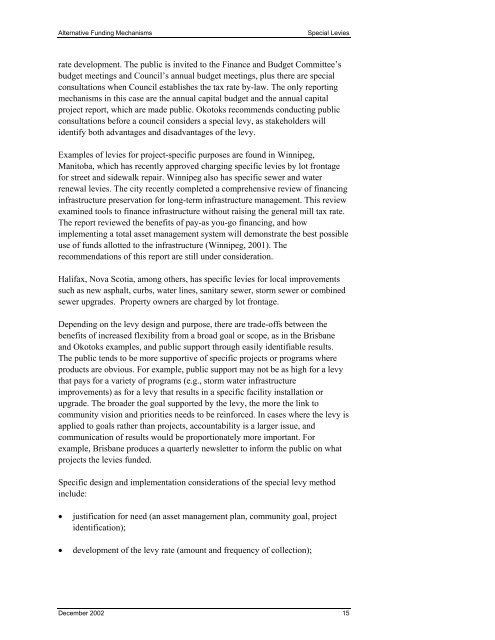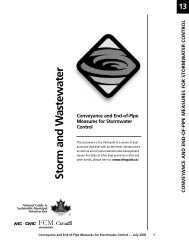ALTERNATIVE FUNDING MECHANISMS - FCM
ALTERNATIVE FUNDING MECHANISMS - FCM
ALTERNATIVE FUNDING MECHANISMS - FCM
You also want an ePaper? Increase the reach of your titles
YUMPU automatically turns print PDFs into web optimized ePapers that Google loves.
Alternative Funding Mechanisms Special Levies<br />
rate development. The public is invited to the Finance and Budget Committee’s<br />
budget meetings and Council’s annual budget meetings, plus there are special<br />
consultations when Council establishes the tax rate by-law. The only reporting<br />
mechanisms in this case are the annual capital budget and the annual capital<br />
project report, which are made public. Okotoks recommends conducting public<br />
consultations before a council considers a special levy, as stakeholders will<br />
identify both advantages and disadvantages of the levy.<br />
Examples of levies for project-specific purposes are found in Winnipeg,<br />
Manitoba, which has recently approved charging specific levies by lot frontage<br />
for street and sidewalk repair. Winnipeg also has specific sewer and water<br />
renewal levies. The city recently completed a comprehensive review of financing<br />
infrastructure preservation for long-term infrastructure management. This review<br />
examined tools to finance infrastructure without raising the general mill tax rate.<br />
The report reviewed the benefits of pay-as you-go financing, and how<br />
implementing a total asset management system will demonstrate the best possible<br />
use of funds allotted to the infrastructure (Winnipeg, 2001). The<br />
recommendations of this report are still under consideration.<br />
Halifax, Nova Scotia, among others, has specific levies for local improvements<br />
such as new asphalt, curbs, water lines, sanitary sewer, storm sewer or combined<br />
sewer upgrades. Property owners are charged by lot frontage.<br />
Depending on the levy design and purpose, there are trade-offs between the<br />
benefits of increased flexibility from a broad goal or scope, as in the Brisbane<br />
and Okotoks examples, and public support through easily identifiable results.<br />
The public tends to be more supportive of specific projects or programs where<br />
products are obvious. For example, public support may not be as high for a levy<br />
that pays for a variety of programs (e.g., storm water infrastructure<br />
improvements) as for a levy that results in a specific facility installation or<br />
upgrade. The broader the goal supported by the levy, the more the link to<br />
community vision and priorities needs to be reinforced. In cases where the levy is<br />
applied to goals rather than projects, accountability is a larger issue, and<br />
communication of results would be proportionately more important. For<br />
example, Brisbane produces a quarterly newsletter to inform the public on what<br />
projects the levies funded.<br />
Specific design and implementation considerations of the special levy method<br />
include:<br />
• justification for need (an asset management plan, community goal, project<br />
identification);<br />
• development of the levy rate (amount and frequency of collection);<br />
December 2002 15
















